

How to Write a Startup Business Plan (10 Effective Steps)
Learn how to create an effective business plan in 10 easy steps and discover the transformative power of mentorship to elevate your startup's strategy.

Robin Waite
5 minute read

Short answer
What should an effective business plan include?
An effective business plan should include the following elements:
- Executive summary
- Company description
- Market analysis
- Your products or services
- Marketing and sales strategies
- Organization and management
- Financial projections
- Funding requirements
- Risk assessment
- Conclusion and Call to Action
You need a strategic business plan to successfully navigate the startup world
Diving into the startup world without a clear plan is like setting sail without a compass ; you might drift aimlessly or even crash.
A solid business plan isn't just a piece of paper—it's your roadmap to success. It attracts the right investors, guides your decisions, and sets you on a clear path to victory.
In this article, I’ll walk you through 10 essential steps to craft that perfect plan. Plus, I’ll touch on the invaluable insights a business mentor can offer.
So, if you want to avoid common pitfalls and boost your chances of success, keep reading. Your startup's future might just depend on it.
Step 1: Executive summary
Think of the executive summary as the elevator pitch for your startup. It's a quick snapshot that captures the heart of your business idea, mission, and goals.
In this brief section, make sure to highlight who your target audience is, what sets you apart in the market, and your unique selling points.
And don't forget to give a glimpse of your financial outlook and any funding needs—it sets the stage for the details that follow.
Here's an example of an executive summary slide:

Step 2: Company description
Here's where you tell your startup's story. It's not just a list of facts or a timeline. It's about painting a picture that connects with your readers.
Clearly outline your vision, mission, and the values that drive you. Share key milestones you've hit and where you currently stand in your business journey. This section gives depth to your startup, showing both where you've been and where you're headed.
Here's an example of a company introduction slide:

Step 3: Market analysis
To thrive, you've got to know the lay of the land. That's where market analysis comes in. Start by zeroing in on your target audience and truly understanding what they're looking for.
Dive deep into industry trends, the overall market size, and where it's headed. And don't just know your competitors—understand what makes you stand out from the crowd.
Here's what a market analysis slide should look like:

Step 4: Products or services
Here's your chance to shine a spotlight on what you're offering. What problems are your products or services solving? What makes them special? Whether it's a unique feature, a patent, or some groundbreaking tech, make it clear why your offerings are game-changers.
Here's an example of a solution slide:

Step 5: Marketing and sales strategies
In today's crowded market, standing out is crucial. This step is all about your game plan to grab attention and win customers. Detail how you'll sell, where you'll promote, and how you'll get your products or services into the hands of those who need them.
Here's what a go-to-market slide should look like:

Step 6: Organization and management
Behind every great startup is a team of passionate people. Here, introduce your squad. Highlight their expertise, define their roles, and show the structure that keeps everything running smoothly.
If you've got advisors or partners in your corner, mention them—it shows you're serious about growing in every direction.
Here’s a full guide on how to create the perfect team slide for your startup . And here's a great example of one:

Step 7: Financial projections
Numbers don't lie, and in this step, they sketch out your startup's potential future. Dive into the financials, projecting where you see your revenue, expenses, and profits heading over the next few years.
By breaking down your initial costs and where you expect to get your funding, you give a clear view of how you're setting up for success.
Here's an example of a financials slide:

Step 8: Funding requirements
Every startup needs fuel to get off the ground, and that fuel is capital. Here, be clear about how much you need to launch and keep things running.
Break down where every dollar will go, whether that's marketing, product development, or daily operations.
If you've already got some backers or have your eye on potential investors, mention them—it adds weight to your pitch.
Here's what a use of funds slide should look like:

Step 9: Risk assessment
Every venture has its bumps in the road. Here, show that you're not just aware of potential challenges but that you've got a plan to tackle them. In assessing risks, it's crucial to choose the right business structure at the beginning. For examples, the formation of an LLC as a strategic measure not only protects your personal assets from business liabilities but also mitigates financial risks for stakeholders. By laying out your strategies for handling risks, you prove you're not just optimistic—you're realistic and ready.
Here's an example of a risk assessment slide:

Step 10: Conclusion and Call to Action
Time to wrap it up and rally your readers. Summarize the key points of your plan, driving home why your startup is a solid bet.
But remember, this isn't just a conclusion—it's a launchpad. Encourage readers to get involved, whether that's investing, partnering, or simply supporting your vision. Let's get this journey started!
And, if you need more information, check out our comprehensive guide on how to write a business plan .
Here's an example of a next step slide:

Seek guidance from a business mentor
While a solid business plan is your startup's compass, adding guidance from a business mentor to your journey is like having a seasoned captain on board.
They bring a treasure trove of insights, lessons from past experiences, and a network of industry contacts. Their tailored advice doesn't just polish your plan—it also boosts your confidence and resilience, two must-haves for the unpredictable startup seas.
By embracing mentorship, you're signaling that you're all in on growth, ready to soak up wisdom and accelerate your path to success.
Why is a business plan crucial for startups?
Think of a business plan as your startup's GPS. It helps you navigate the twists and turns, pointing out both the challenges and the golden opportunities ahead. It's your master blueprint, detailing everything from your big-picture goals to your financial forecasts .
What role does a business mentor play in this process?
A business mentor serves as a seasoned guide in the startup journey. Drawing from their wealth of experience, they offer invaluable insights, helping startups navigate challenges and optimize their strategies. Their guidance is instrumental in making informed, strategic decisions.
How can a mentor enhance my market analysis?
Mentors have their finger on the pulse of the industry. They can help you get a clearer picture of market trends, spot who you're really up against, and gauge where the opportunities lie. With their insights, your market analysis won't just be good—it'll be top-notch.
Can a mentor assist in financial projections?
Absolutely. If your mentor has a financial background, they can be a goldmine. They'll help you craft projections that are both ambitious and grounded in reality. From revenue estimates to potential expenses, they'll ensure your numbers make sense.
How can you incorporate mentorship into the business plan?
Consider adding a dedicated section in your business plan to highlight the mentorship aspect. By detailing the insights and guidance you've received, or intend to seek, you underscore your commitment to informed growth. This proactive approach can resonate well with potential investors and stakeholders.
Business plan templates
Starting your business plan can feel like staring at a blank canvas—it's full of potential, but where do you begin? That's where interactive business plan templates come into play.
These templates serve as a structured guide, ensuring you don't miss any crucial details while allowing for flexibility and customization. They're designed to streamline the process, making it easier to organize your thoughts and present your vision in a coherent manner.
Ready to dive in? Grab a template from the library below and give your business plan a head start.

Robin Waite is a business coach based in the UK, bestselling author, and also regular business speaker. Robin's Fearless Business Accelerator covers pricing, productising services, and sales for coaches, consultants, and freelancers. Robin's passion is content marketing and blogging and he enjoys finding creative ways to make complex business topics simple for his readers.

Found this post useful?
Subscribe to our monthly newsletter.
Get notified as more awesome content goes live.
(No spam, no ads, opt-out whenever)
You've just joined an elite group of people that make the top performing 1% of sales and marketing collateral.
Create your best business plan to date
Try Storydoc interactive presentation maker for 14 days free (keep any presentation you make forever!)
Home > Business > Business Startup
How To Write a Business Plan
We are committed to sharing unbiased reviews. Some of the links on our site are from our partners who compensate us. Read our editorial guidelines and advertising disclosure .

Starting a business is a wild ride, and a solid business plan can be the key to keeping you on track. A business plan is essentially a roadmap for your business — outlining your goals, strategies, market analysis and financial projections. Not only will it guide your decision-making, a business plan can help you secure funding with a loan or from investors .
Writing a business plan can seem like a huge task, but taking it one step at a time can break the plan down into manageable milestones. Here is our step-by-step guide on how to write a business plan.
Table of contents
- Write your executive summary
- Do your market research homework
- Set your business goals and objectives
- Plan your business strategy
- Describe your product or service
- Crunch the numbers
- Finalize your business plan

By signing up I agree to the Terms of Use and Privacy Policy .
Step 1: Write your executive summary
Though this will be the first page of your business plan , we recommend you actually write the executive summary last. That’s because an executive summary highlights what’s to come in the business plan but in a more condensed fashion.
An executive summary gives stakeholders who are reading your business plan the key points quickly without having to comb through pages and pages. Be sure to cover each successive point in a concise manner, and include as much data as necessary to support your claims.
You’ll cover other things too, but answer these basic questions in your executive summary:
- Idea: What’s your business concept? What problem does your business solve? What are your business goals?
- Product: What’s your product/service and how is it different?
- Market: Who’s your audience? How will you reach customers?
- Finance: How much will your idea cost? And if you’re seeking funding, how much money do you need? How much do you expect to earn? If you’ve already started, where is your revenue at now?
Step 2: Do your market research homework
The next step in writing a business plan is to conduct market research . This involves gathering information about your target market (or customer persona), your competition, and the industry as a whole. You can use a variety of research methods such as surveys, focus groups, and online research to gather this information. Your method may be formal or more casual, just make sure that you’re getting good data back.
This research will help you to understand the needs of your target market and the potential demand for your product or service—essential aspects of starting and growing a successful business.
Step 3: Set your business goals and objectives
Once you’ve completed your market research, you can begin to define your business goals and objectives. What is the problem you want to solve? What’s your vision for the future? Where do you want to be in a year from now?
Use this step to decide what you want to achieve with your business, both in the short and long term. Try to set SMART goals—specific, measurable, achievable, relevant, and time-bound benchmarks—that will help you to stay focused and motivated as you build your business.
Step 4: Plan your business strategy
Your business strategy is how you plan to reach your goals and objectives. This includes details on positioning your product or service, marketing and sales strategies, operational plans, and the organizational structure of your small business.
Make sure to include key roles and responsibilities for each team member if you’re in a business entity with multiple people.
Step 5: Describe your product or service
In this section, get into the nitty-gritty of your product or service. Go into depth regarding the features, benefits, target market, and any patents or proprietary tech you have. Make sure to paint a clear picture of what sets your product apart from the competition—and don’t forget to highlight any customer benefits.
Step 6: Crunch the numbers
Financial analysis is an essential part of your business plan. If you’re already in business that includes your profit and loss statement , cash flow statement and balance sheet .
These financial projections will give investors and lenders an understanding of the financial health of your business and the potential return on investment.
You may want to work with a financial professional to ensure your financial projections are realistic and accurate.
Step 7: Finalize your business plan
Once you’ve completed everything, it's time to finalize your business plan. This involves reviewing and editing your plan to ensure that it is clear, concise, and easy to understand.
You should also have someone else review your plan to get a fresh perspective and identify any areas that may need improvement. You could even work with a free SCORE mentor on your business plan or use a SCORE business plan template for more detailed guidance.
Compare the Top Small-Business Banks
Data effective 1/10/23. At publishing time, rates, fees, and requirements are current but are subject to change. Offers may not be available in all areas.
The takeaway
Writing a business plan is an essential process for any forward-thinking entrepreneur or business owner. A business plan requires a lot of up-front research, planning, and attention to detail, but it’s worthwhile. Creating a comprehensive business plan can help you achieve your business goals and secure the funding you need.
Related content
- 5 Best Business Plan Software and Tools in 2023 for Your Small Business
- How to Get a Business License: What You Need to Know
- What Is a Cash Flow Statement?
Best Small Business Loans

5202 W Douglas Corrigan Way Salt Lake City, UT 84116
Accounting & Payroll
Point of Sale
Payment Processing
Inventory Management
Human Resources
Other Services
Best Inventory Management Software
Best Small Business Accounting Software
Best Payroll Software
Best Mobile Credit Card Readers
Best POS Systems
Best Tax Software
Stay updated on the latest products and services anytime anywhere.
By signing up, you agree to our Terms of Use and Privacy Policy .
Disclaimer: The information featured in this article is based on our best estimates of pricing, package details, contract stipulations, and service available at the time of writing. All information is subject to change. Pricing will vary based on various factors, including, but not limited to, the customer’s location, package chosen, added features and equipment, the purchaser’s credit score, etc. For the most accurate information, please ask your customer service representative. Clarify all fees and contract details before signing a contract or finalizing your purchase.
Our mission is to help consumers make informed purchase decisions. While we strive to keep our reviews as unbiased as possible, we do receive affiliate compensation through some of our links. This can affect which services appear on our site and where we rank them. Our affiliate compensation allows us to maintain an ad-free website and provide a free service to our readers. For more information, please see our Privacy Policy Page . |
© Business.org 2024 All Rights Reserved.
18 of My Favorite Sample Business Plans & Examples For Your Inspiration
Updated: July 01, 2024
Published: November 08, 2018
I believe that reading sample business plans is essential when writing your own.

hbspt.cta._relativeUrls=true;hbspt.cta.load(53, 'e9d2eacb-6b01-423a-bf7a-19d42ba77eaa', {"useNewLoader":"true","region":"na1"});
As you explore business plan examples from real companies and brands, it’s easier for you to learn how to write a good one.
So what does a good business plan look like? And how do you write one that’s both viable and convincing? I’ll walk you through the ideal business plan format along with some examples to help you get started.
Table of Contents
Business Plan Types
Business plan format, sample business plan: section by section, sample business plan templates, top business plan examples.
Ultimately, the format of your business plan will vary based on your goals for that plan. I’ve added this quick review of different business plan types that achieve differing goals.
For a more detailed exploration of business plan types, you can check out this post .
.webp)
Free Business Plan Template
The essential document for starting a business -- custom built for your needs.
- Outline your idea.
- Pitch to investors.
- Secure funding.
- Get to work!
Download Free
All fields are required.
You're all set!
Click this link to access this resource at any time.
1. Startups
Startup business plans are for proposing new business ideas. If you’re planning to start a small business, preparing a business plan is crucial. The plan should include all the major factors of your business.
You can check out this guide for more detailed business plan inspiration .
2. Feasibility Studies
Feasibility business plans focus on that business's product or service. Feasibility plans are sometimes added to startup business plans. They can also be a new business plan for an already thriving organization.
3. Internal Use
You can use internal business plans to share goals, strategies, or performance updates with stakeholders. In my opinion, internal business plans are useful for alignment and building support for ambitious goals.
4. Strategic Initiatives
A strategic business plan is another business plan that's often shared internally. This plan covers long-term business objectives that might not have been included in the startup business plan.
5. Business Acquisition or Repositioning
When a business is moving forward with an acquisition or repositioning, it may need extra structure and support. These types of business plans expand on a company's acquisition or repositioning strategy.
Growth sometimes just happens as a business continues operations. But more often, a business needs to create a structure with specific targets to meet set goals for expansion. This business plan type can help a business focus on short-term growth goals and align resources with those goals.
I’m going to focus on a startup business plan that needs to be detailed and research-backed as well as compelling enough to convince investors to offer funding. In my experience, the most comprehensive and convincing business plans contain the following sections.
Executive Summary
This all-important introduction to your business plan sets the tone and includes the company description as well as what you will be exchanging for money — whether that’s product lines, services, or product-service hybrids.
Market Opportunity
Information about gaps in your industry’s market and how you plan to fill them, focused on demand and potential for growth.
Competitive Landscape Analysis
An overview of your competitors that includes consideration of their strengths and how you’ll manage them, their weaknesses and how you’ll capitalize on them, and how you can differentiate your offerings in the industry.
Target Audience
Descriptions of your ideal customers, their various problems that you can solve, and your customer acquisition strategy.
Marketing Strategy
This section details how you will market your brand to achieve specific goals, the channels and tactics you’ll utilize to reach those goals, and the metrics you’ll be using to measure your progress.
Key Features and Benefits
This is where you’ll use plain language to emphasize the value of your product/service, how it solves the problems of your target audiences, and how you’ll scale up over time.
Pricing and Revenue
This section describes your pricing strategy and plans for building revenue streams that fit your audiences while achieving your business goals.
This is the final section, communicating with investors that your business idea is worth investing in via profit/loss statements, cash flow statements, and balance sheets to prove viability.
Okay, so now that we have a format established, I’ll give you more specific details about each section along with examples. Truthfully, I wish I’d had this resource to help me flesh out those first business plans long ago.
1. Executive Summary
I’d say the executive summary is the most important section of the entire business plan. It is essentially an overview of and introduction to your entire project.
Write this in such a way that it grabs your readers' attention and guides them through the rest of the business plan. This is important because a business plan can be dozens or hundreds of pages long.
There are two main elements I’d recommend including in your executive summary: your company description and your products and services.
Company Description
This is the perfect space to highlight your company’s mission statement and goals, a brief overview of your history and leadership, and your top accomplishments as a business.
Tell potential investors who you are and why what you do matters. Naturally, they’re going to want to know who they’re getting into business with up front. This is a great opportunity to showcase your impact.
Need some extra help firming up your business goals? I’d recommend HubSpot Academy’s free course to help you set meaningful goals that matter most for your business.
Products and Services
Here, you will incorporate an overview of your offerings. This doesn’t have to be extensive, as it is just a chance to introduce your industry and overall purpose as a business. I recommend including snippets of information about your financial projections and competitive advantage here as well.
Keep in mind that you'll cover many of these topics in more detail later on in the business plan. The executive summary should be clear and brief, only including the most important takeaways.
Executive Summary Business Plan Examples
This example was created with HubSpot’s business plan template . What makes this executive summary good is that it tells potential investors a short story while still covering all of the most important details.
Our Mission
Maria’s Gluten Free Bagels offers gluten-free bagels, along with various toppings, other gluten-free breakfast sandwich items, and coffee. The facility is entirely gluten free. Our team expects to catch the interest of gluten-free, celiac, or health-conscious community members who are seeking an enjoyable cafe to socialize. Due to a lack of gluten-free bagel products in the food industry currently, we expect mild competition and are confident we will be able to build a strong market position.
The Company and Management
Maria’s Gluten Free Bagels was founded in 2010 by Maria Jones, who first began selling her gluten-free bagels online from her home, using social media to spread the word. In 2012 she bought a retail location in Hamilton, MA, which now employs four full-time employees and six part-time employees. Prior to her bagel shop, Maria was a chef in New York and has extensive experience in the food industry.
Along with Maria Jones, Gluten Free Bagel Shop has a board of advisors. The advisors are:
- Jeni King, partner at Winding Communications, Ltd.
- Henry Wilson, president of Blue Robin, LLP.
Our Product
We offer gluten-free products ranging from bagels and cream cheese to blueberry muffins, coffee, and pastries. Our customers are health-conscious, community-oriented people who enjoy gluten-free products. We will create a welcoming, warm environment with opportunities for open mic nights, poetry readings, and other community functions. We will focus on creating an environment in which someone feels comfortable meeting a friend for lunch, or working remotely.
Our Competitive Advantages
While there are other coffee shops and cafes in the North Shore region, there are none that offer purely gluten-free options. This restricts those suffering from gluten-free illnesses or simply those with a gluten-free preference. This will be our primary selling point. Additionally, our market research [see Section 3] has shown a demand for a community-oriented coffee and bagel shop in the town of Hamilton, MA.
Financial Considerations
Our sales projections for the first year are $400,000. We project a 15% growth rate over the next two years. By year three, we project 61% gross margins.
We will have four full-time employees. The salary for each employee will be $50,000.
Start-up Financing Requirements
We are seeking to raise $125,000 in startup to finance year one. The owner has invested $50,000 to meet working capital requirements, and will use a loan of $100,000 to supplement the rest.
Example 2 :
Marianne and Keith Bean have been involved with the food industry for several years. They opened their first restaurant in Antlers, Oklahoma in 1981, and their second in Hugo in 1988. Although praised for the quality of many of the items on their menu, they have attained a special notoriety for their desserts. After years of requests for their flavored whipped cream toppings, they have decided to pursue marketing these products separately from the restaurants.
Marianne and Keith Bean have developed several recipes for flavored whipped cream topping. They include chocolate, raspberry, cinnamon almond, and strawberry. These flavored dessert toppings have been used in the setting of their two restaurants over the past 18 years, and have been produced in large quantities. The estimated shelf life of the product is 21 days at refrigeration temperatures and up to six months when frozen. The Beans intend to market this product in its frozen state in 8 and 12-ounce plastic tubs. They also intend to have the products available in six ounce pressurized cans. Special attention has been given to developing an attractive label that will stress the gourmet/specialty nature of the products.
Distribution of Fancy's Foods Whipped Dream product will begin in the local southeastern Oklahoma area. The Beans have an established name and reputation in this area, and product introduction should encounter little resistance.
Financial analyses show that the company will have both a positive cash flow and profit in the first year. The expected return on equity in the first year is 10.88%
Tips for Writing Your Executive Summary
- Start with a strong introduction of your company that showcases your mission and impact, then outline the products and services you provide.
- Clearly define a problem, explain how your product solves that problem, and show why the market needs your business.
- Be sure to highlight your value proposition, market opportunity, and growth potential.
- Keep it concise and support ideas with data.
- Customize your summary to your audience. For example, you might emphasize finances and return on investment for venture capitalists, whereas you might emphasize community benefits and minimal environmental impact for progressive nonprofits.
For more guidance, check out our tips for writing an effective executive summary .
2. Market Opportunity
This is where you'll detail the opportunity in the market. Ask and answer: Where is the gap in the current industry, and how will my product fill that gap?
To get a thorough understanding of the market opportunity, you'll want to conduct a TAM, SAM, SOM analysis , a SWOT analysis , and perform market research on your industry to get some insights for this section. More specifically, here’s what I’d include.
- The size of the market
- Current or potential market share
- Trends in the industry and consumer behavior
- Where the gap is
- What caused the gap
- How you intend to fill it
Market Opportunity Business Plan Example
I like this example because it uses critical data to underline the size of the potential market and what part of that market this service hopes to capture.
Example: The market for Doggie Pause is all of the dog owners in the metropolitan area and surrounding areas of the city. We believe that this is going to be 2/3 of the population, and we have a goal of gaining a 50% market share. We have a target of a 20% yearly profit increase as the business continues.
Tips for Writing Your Market Opportunity Section
- Focus on demand and potential for growth.
- Use market research, surveys, and industry trend data to support your market forecast and projections.
- Add a review of regulation shifts, tech advances, and consumer behavior changes.
- Refer to reliable sources.
- Showcase how your business can make the most of this opportunity.
3. Competitive Landscape Analysis
Since we’re already speaking of market share, you‘ll also need to create a section that shares details on who the top competitors are. After all, your customers likely have more than one brand to choose from, and you’ll want to understand exactly why they might choose one over another.
My favorite part of performing a competitive analysis is that it can help you uncover the following:
- Industry trends that other brands may not be utilizing.
- Strengths in your competition that may be obstacles to handle.
- Weaknesses in your competition that may help you develop selling points.
- The unique proposition you bring to the market that may resonate with customers.
Competitive Landscape Business Plan Example
I like how the competitive landscape section of this business plan shows a clear outline of who the top competitors are. It also highlights specific industry knowledge and the importance of location. This demonstrates useful experience in the industry, helping to build trust in your ability to execute your business plan.
Competitive Environment
Currently, there are four primary competitors in the Greater Omaha Area: Pinot’s Palette Lakeside (franchise partner), Village Canvas and Cabernet, The Corky Canvas, and Twisted Vine Collective. The first three competitors are in Omaha and the fourth is located in Papillion.
Despite the competition, all locations have both public and private events. Each location has a few sold-out painting events each month. The Omaha locations are in new, popular retail locations, while the existing Papillion location is in a downtown business district.
There is an opportunity to take advantage of the environment and open a studio in a well-traveled or growing area. Pinot’s Palette La Vista will differentiate itself from its competitors by offering a premium experience in a high-growth, influential location.
Tips for Writing Your Competitive Landscape
- Complete in-depth research, then emphasize your most important findings.
- Compare your unique selling proposition (USP) to your direct and indirect competitors.
- Show a clear and realistic plan for product and brand differentiation.
- Look for specific advantages and barriers in the competitive landscape. Then, highlight how that information could impact your business.
- Outline growth opportunities from a competitive perspective.
- Add customer feedback and insights to support your competitive analysis.
4. Target Audience
Use this section to describe who your customer segments are in detail. What is the demographic and psychographic information of your audience? I’d recommend building a buyer persona to get in the mindset of your ideal customers and be clear about why you're targeting them. Here are some questions I’d ask myself:
- What demographics will most likely need/buy your product or service?
- What are the psychographics of this audience? (Desires, triggering events, etc.)
- Why are your offerings valuable to them?
Target Audience Business Plan Example
I like the example below because it uses in-depth research to draw conclusions about audience priorities. It also analyzes how to create the right content for this audience.
The Audience
Recognize that audiences are often already aware of important issues. Outreach materials should:
- Emphasize a pollution-prevention practice
- Tell audience a little about how to prevent pollution
- Tell audience where they can obtain information about prevention.
Message Content
- Focus the content for outreach materials on cost savings, such as when and where pollution prevention is as cheap as or cheaper than traditional techniques. Include facts and figures.
- Emphasize how easy it is to do the right thing and the impacts of not engaging in pollution prevention.
- Stress benefits such as efficiency or better relations with government, for businesses not primarily concerned with public image.
Tips for Writing Your Target Audience Section
- Include details on the size and growth potential of your target audience.
- Figure out and refine the pain points for your target audience , then show why your product is a useful solution.
- Describe your targeted customer acquisition strategy in detail.
- Share anticipated challenges your business may face in acquiring customers and how you plan to address them.
- Add case studies, testimonials, and other data to support your target audience ideas.
- Remember to consider niche audiences and segments of your target audience in your business plan.
5. Marketing Strategy
Here, you‘ll discuss how you’ll acquire new customers with your marketing strategy. I think it’s helpful to have a marketing plan built out in advance to make this part of your business plan easier. I’d suggest including these details:
- Your brand positioning vision and how you'll cultivate it.
- The goal targets you aim to achieve.
- The metrics you'll use to measure success.
- The channels and distribution tactics you'll use.
Marketing Strategy Business Plan Example
This business plan example includes the marketing strategy for the town of Gawler. In my opinion, it works because it offers a comprehensive picture of how they plan to use digital marketing to promote the community.
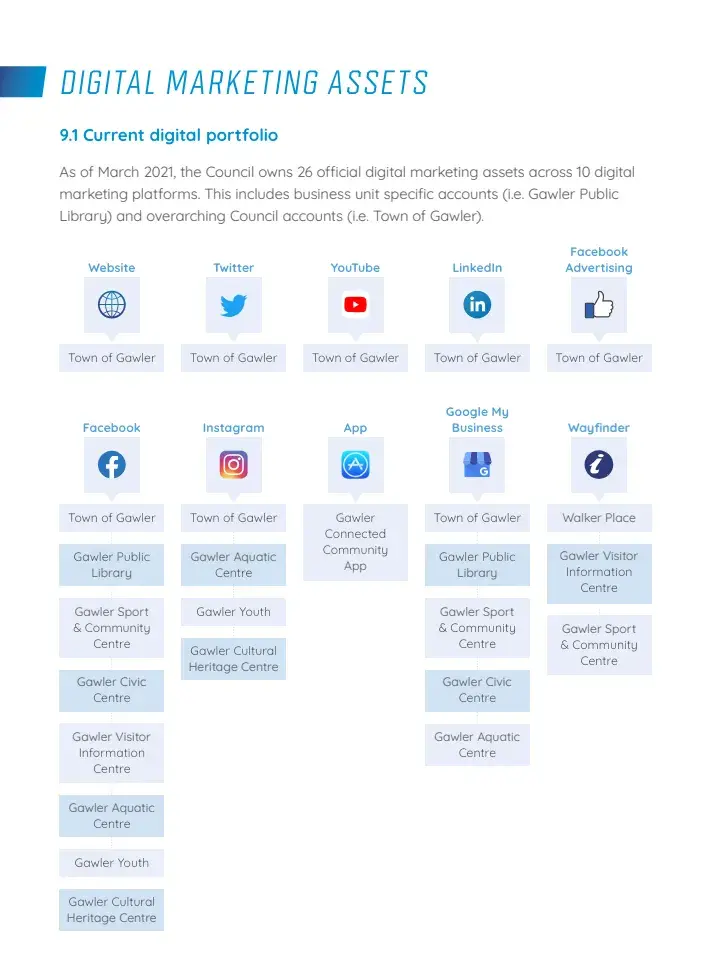

Why I Like It
This one-page business plan is a fantastic choice for the new business owner who doesn’t have the time or resources to draft a full-blown business plan. It includes all the essential sections in an accessible, bullet-point-friendly format. That way, you can get the broad strokes down before honing in on the details.
2. HubSpot's Downloadable Business Plan Template
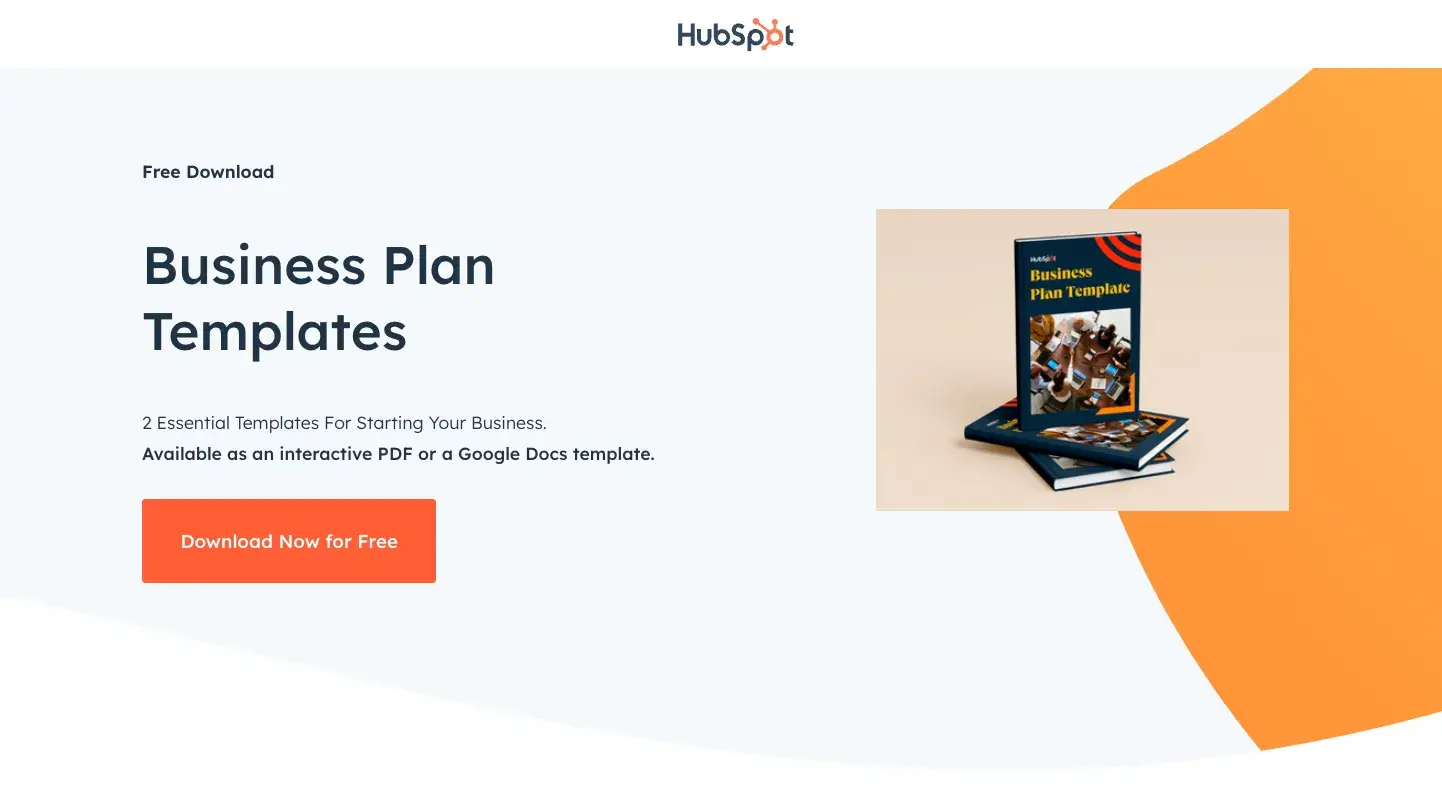
You’ll also learn the financial benefits investors can reap from putting money into your venture rather than trying to sell them on how great your product or service is.
This business plan guide focuses less on the individual parts of a business plan, and more on the overarching goal of writing one. For that reason, it’s one of my favorites to supplement any template you choose to use. Harvard Business Review’s guide is instrumental for both new and seasoned business owners.
7. HubSpot’s Complete Guide to Starting a Business
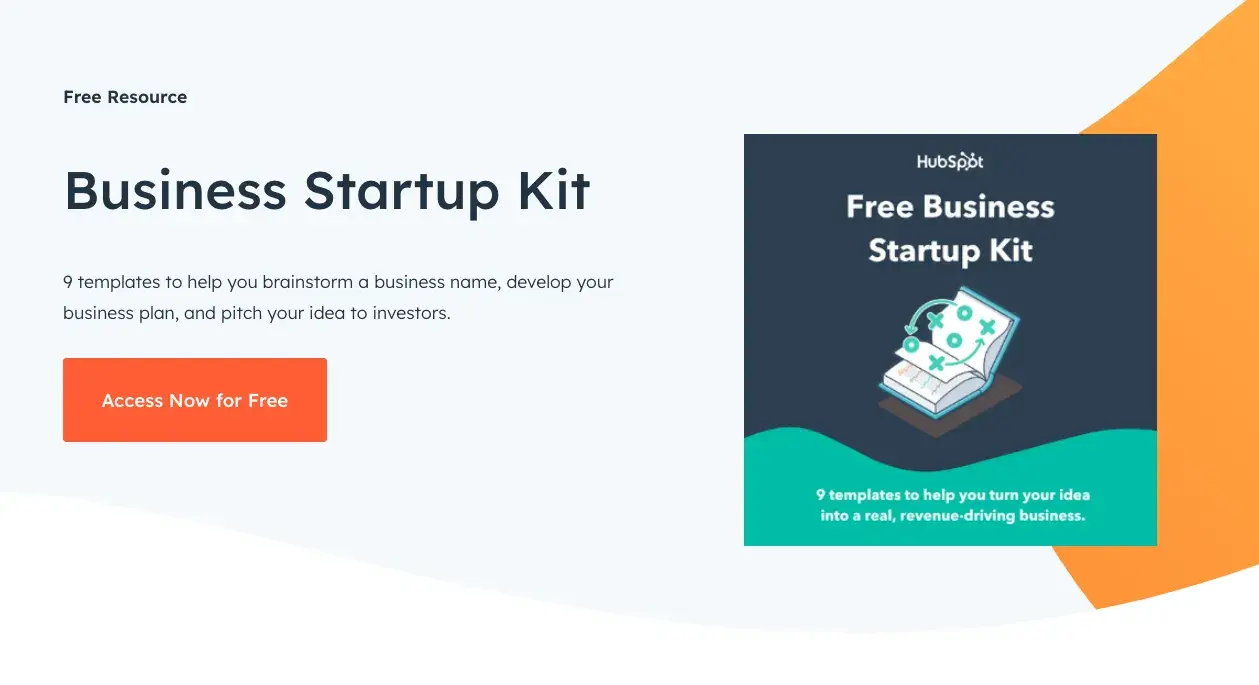
The Best AI Tools for Ecommerce & How They'll Boost Your Business

23 of My Favorite Free Marketing Newsletters
![business plans startup The 8 Best Free Flowchart Templates [+ Examples]](https://www.hubspot.com/hubfs/free-flowchart-template-1-20240716-6679104-1.webp)
The 8 Best Free Flowchart Templates [+ Examples]

What is a Business Plan? Definition, Tips, and Templates
![business plans startup 7 Gantt Chart Examples You'll Want to Copy [+ 5 Steps to Make One]](https://www.hubspot.com/hubfs/gantt-chart-1-20240625-3861486-1.webp)
7 Gantt Chart Examples You'll Want to Copy [+ 5 Steps to Make One]
![business plans startup How to Write an Executive Summary Execs Can't Ignore [+ 5 Top Examples]](https://www.hubspot.com/hubfs/executive-summary-example_5.webp)
How to Write an Executive Summary Execs Can't Ignore [+ 5 Top Examples]
21 Free & Paid Small Business Tools for Any Budget

Maximizing Your Social Media Strategy: The Top Aggregator Tools to Use

The Content Aggregator Guide for 2024

16 Best Screen Recorders to Use for Collaboration
2 Essential Templates For Starting Your Business
Marketing software that helps you drive revenue, save time and resources, and measure and optimize your investments — all on one easy-to-use platform
Free Startup Business Plan Templates and Examples
By Joe Weller | May 6, 2020
- Share on Facebook
- Share on LinkedIn
Link copied
In this article, we’ve rounded up a variety of the top, professionally designed startup business plan templates, all of which are free to download in PDF, Word, and Excel formats.
Included on this page, you’ll find a one-page startup business plan template , a business plan outline template for startups , a startup business planning template with a timeline , and a sample startup business plan .
Startup Business Plan Template
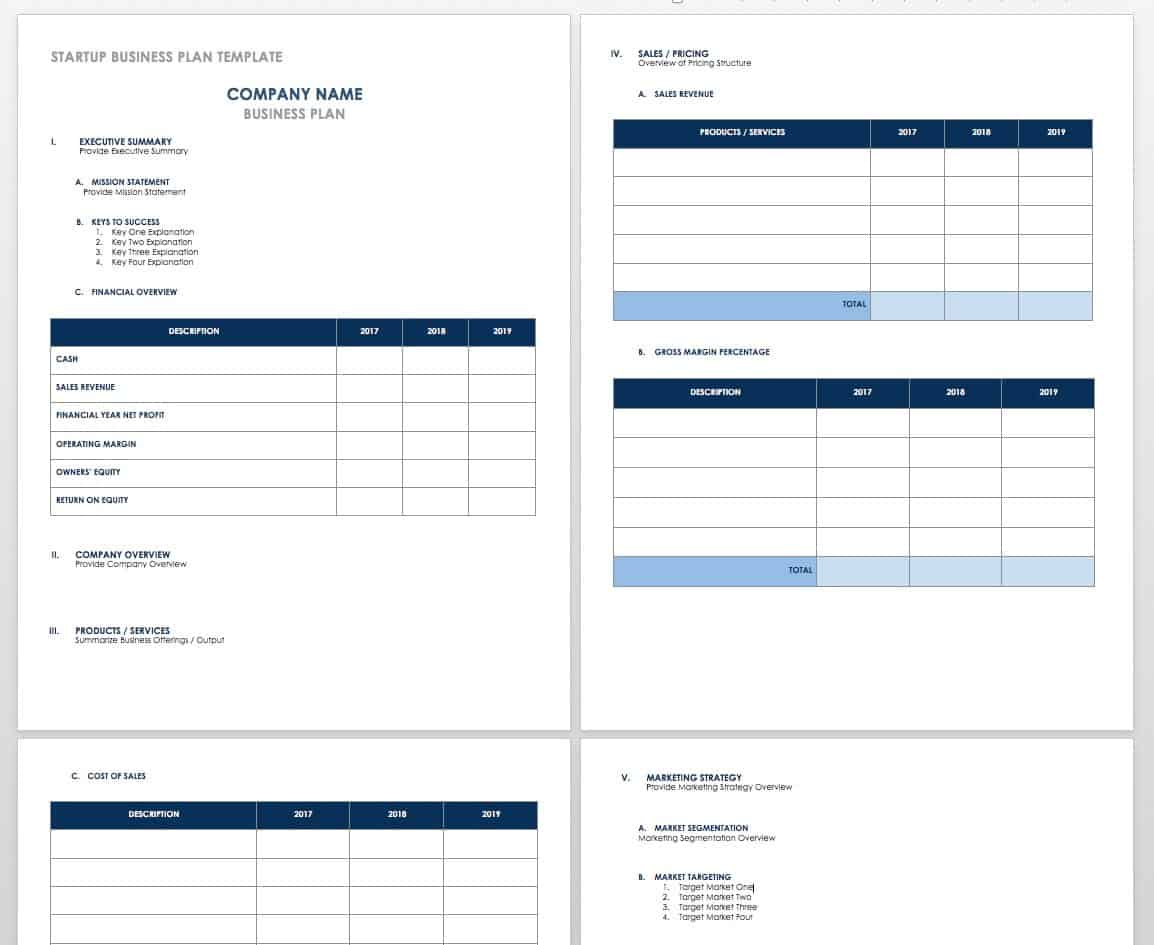
Download Startup Business Plan Template - Word
Word | Smartsheet
This startup business plan template contains the essential components you need to convey your business idea and strategy to investors and stakeholders, but you can customize this template to fit your needs. The template provides room to include an executive summary, a financial overview, a marketing strategy, details on product or service offerings, and more.
One-Page Startup Business Plan Template
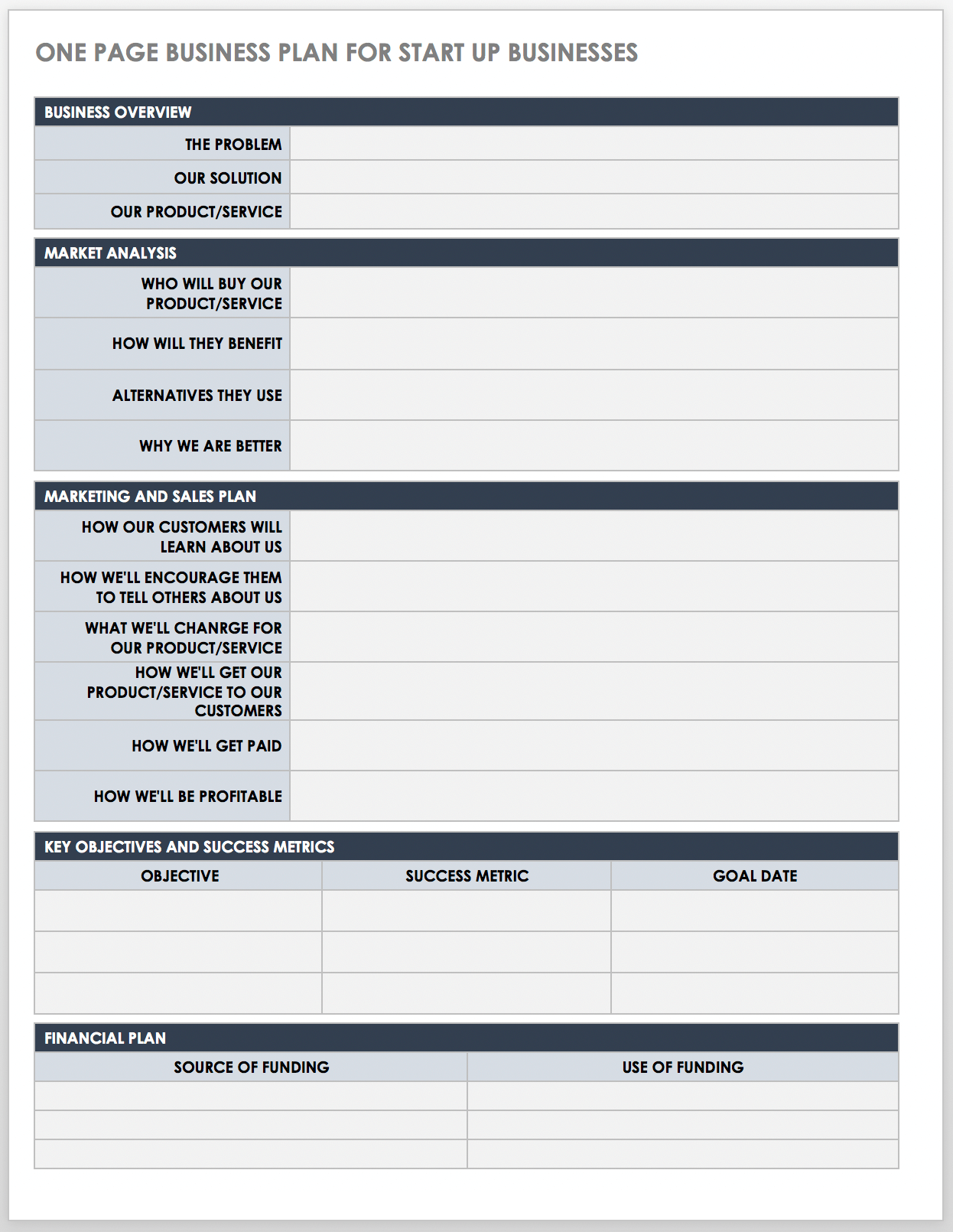
Download One-Page Startup Business Plan Template
Excel | Word | PDF
This one-page business plan is ideal for startup companies that want to document and organize key business concepts. The template offers an easy-to-scan layout that’s ideal for investors and stakeholders. Use this plan to create a high-level view of your business idea and as a reference as you flesh out a more detailed roadmap for your business.
For additional resources, visit " Free One-Page Business Plan Templates with a Quick How-To Guide ."
Simple Fill-In-the-Blank Business Plan Template for Startups
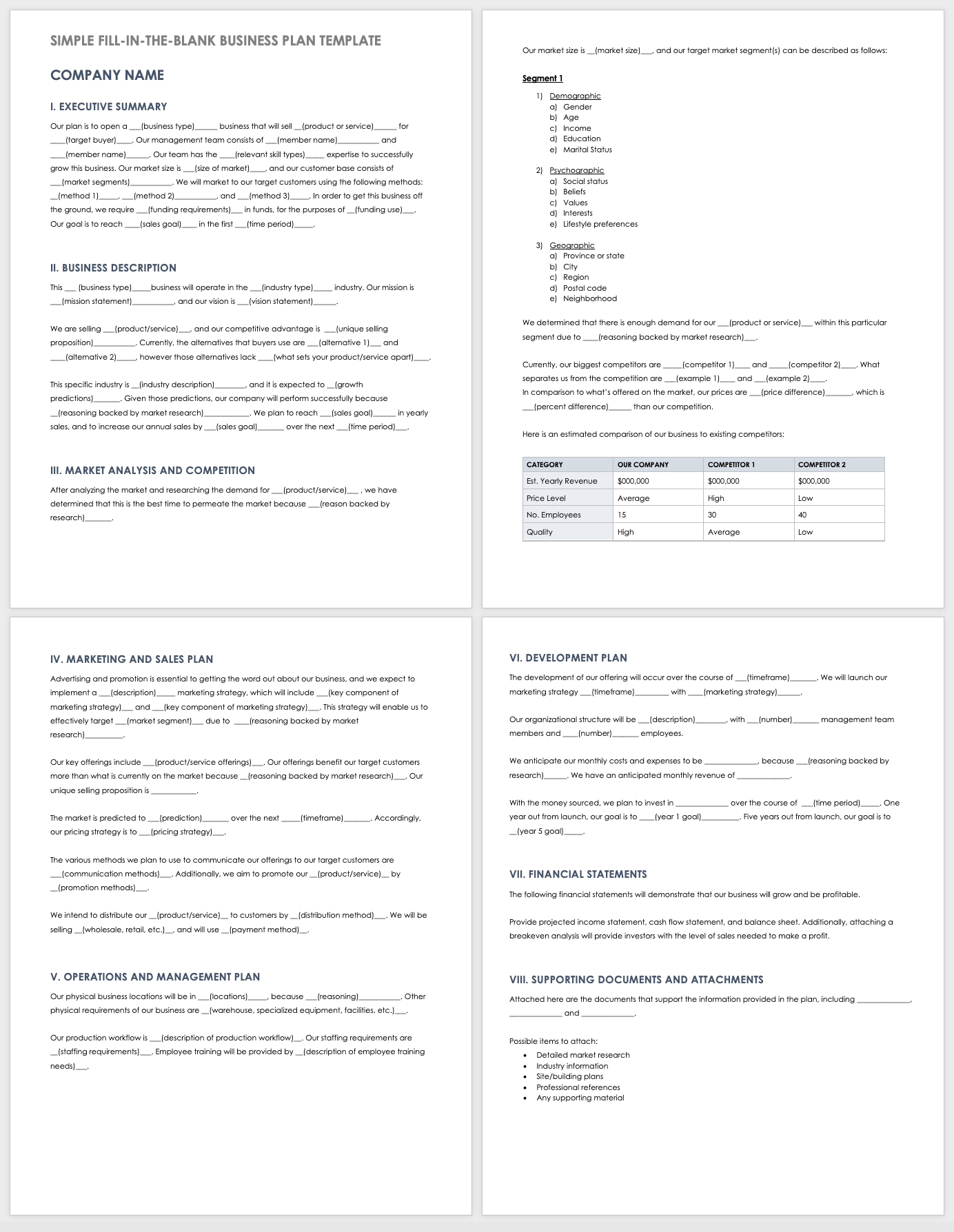
Download Simple Fill-in-the-Blank Business Plan Template for Startups
This comprehensive fill-in-the-blank business plan template is designed to guide entrepreneurs through the process of building a startup business plan. This template comes with a customizable cover page and table of contents, and each section includes sample content that you can modify to fit the needs of your business. For more fill-in business templates, read our "Free Fill-In-the-Blank Business Plan Templates" article.
Lean Business Plan Template for Startups
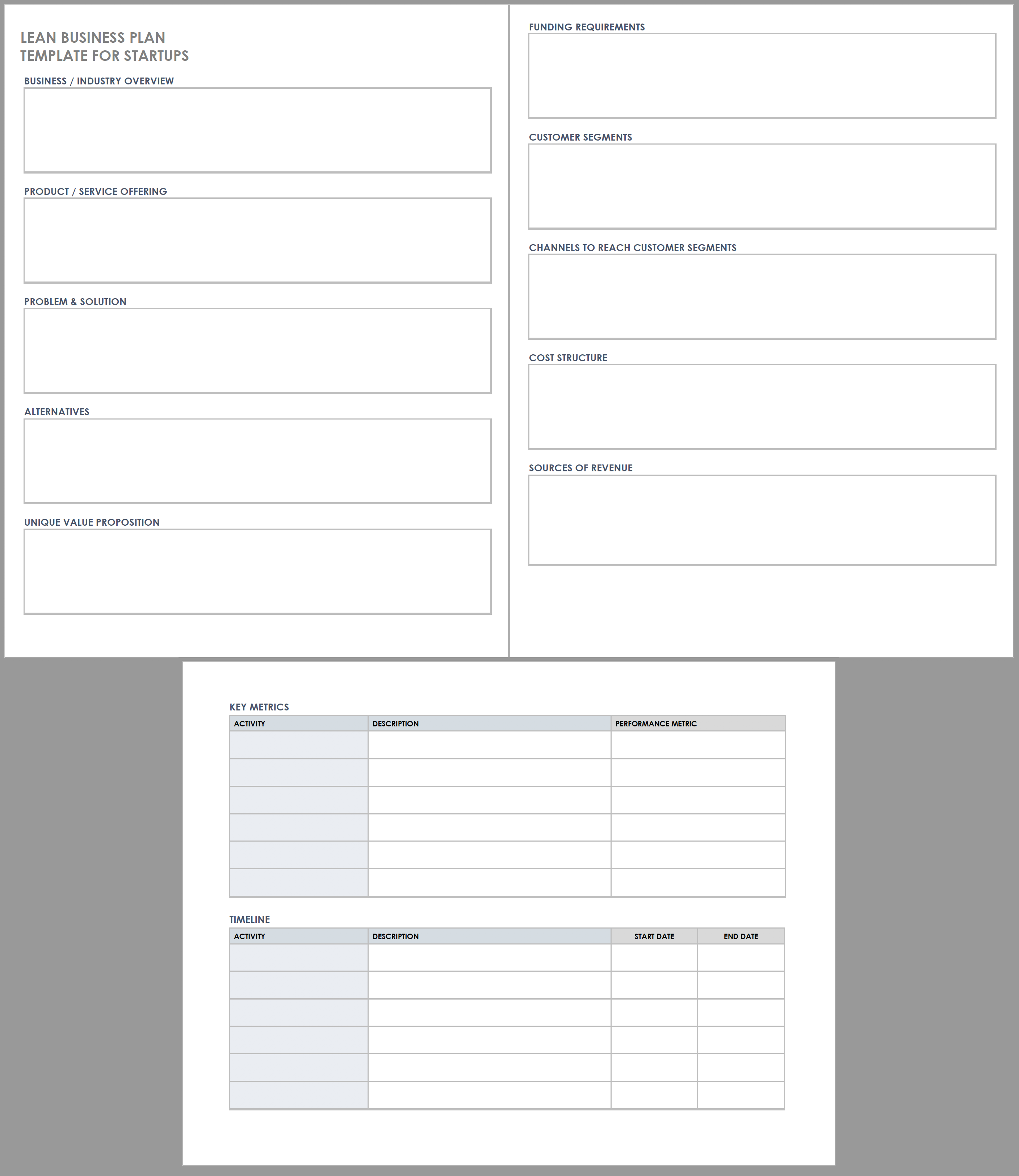
Download Lean Business Plan Template for Startups
This Lean business plan template takes a traditional business plan outline and extracts the most essential elements. Use this template to outline your company and industry overview, convey the problem you are solving, identify customer segments, highlight key performance metrics, and list a timeline of key activities.
Business Plan Outline Template for Startups

Download Business Plan Outline Template for Startups
You can use this business plan outline as a basis to create your own business plan. This template contains all the elements of a traditional business plan, including a title page, a table of contents, and information on what to include in each section. Simplify or expand this outline based on the size and needs of your startup business.
Startup Business Planning Template with Timeline
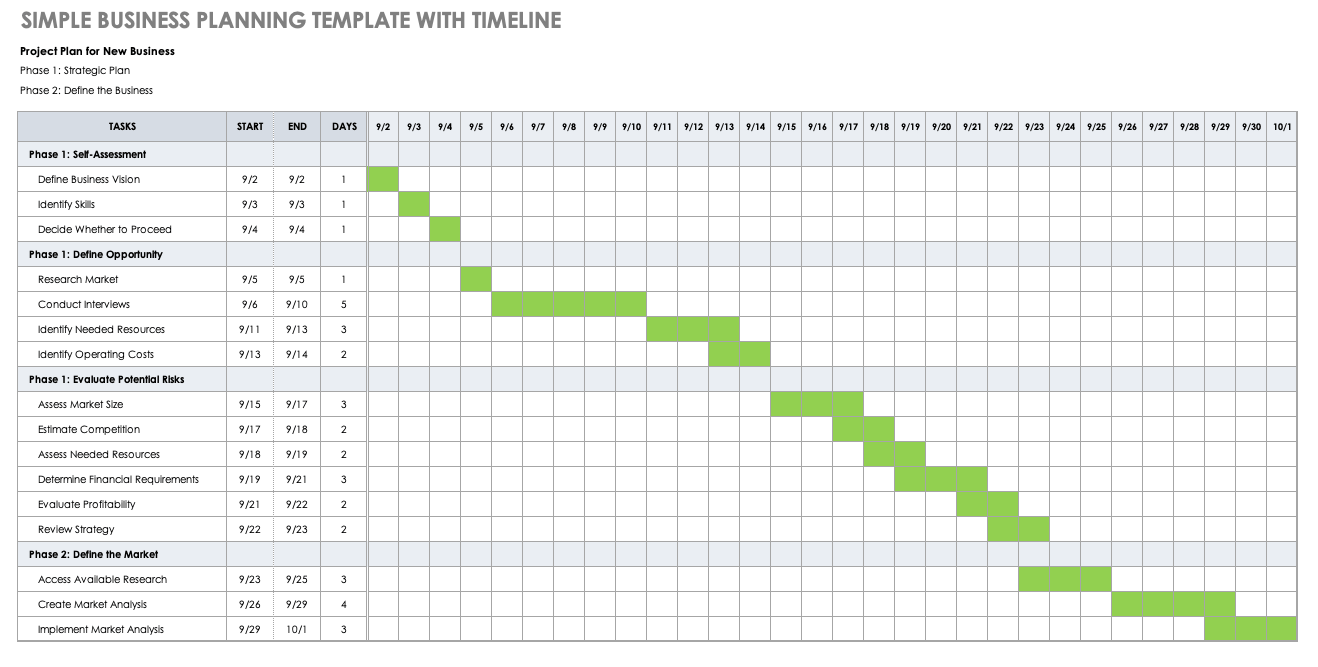
Download Startup Business Planning Template with Timeline
Excel | Smartsheet
As you create your business plan, this business planning template doubles as a schedule and timeline to track the progress of key activities. This template enables you to break down your plan into phases and provides space to include key tasks and dates for each task. For a visual timeline, shade in the cells according to each task’s start and end dates. The timeline ensures that your plan stays on track.
Business Plan Rubric Template for Startups
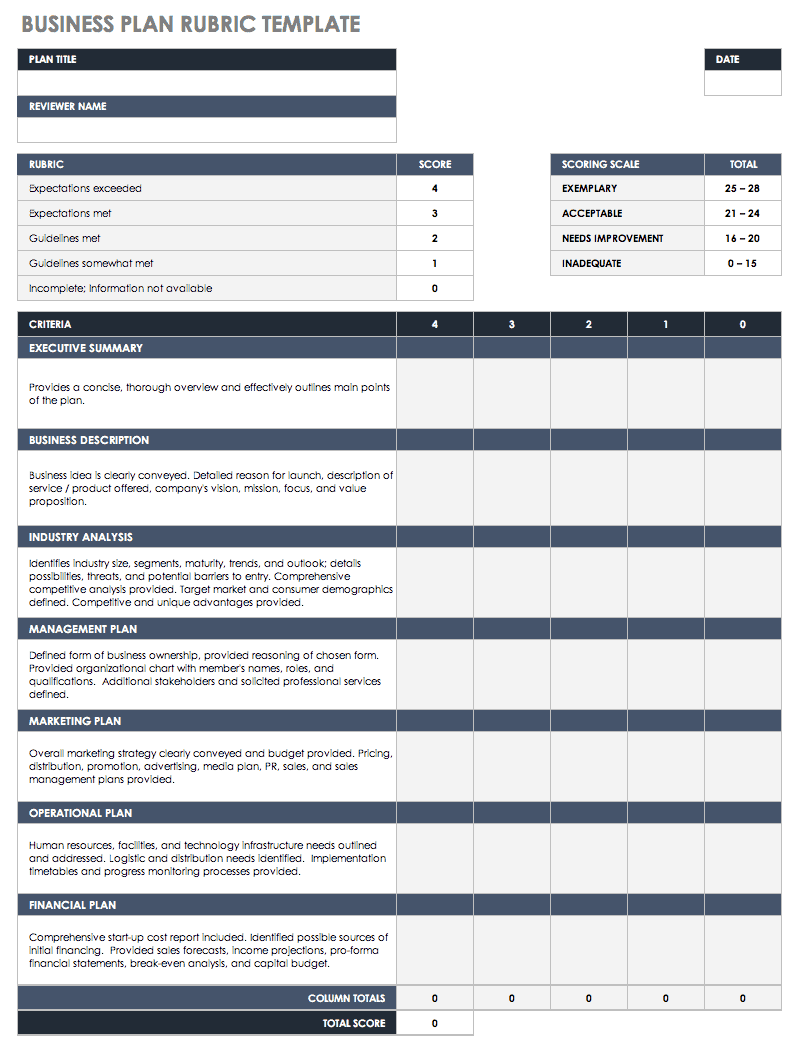
Download Business Plan Rubric Template for Startups
Excel | Word | PDF | Smartsheet
If you’re starting a business and want to keep all your ducks in a row, use this rubric to evaluate and score each aspect of your startup business plan. You can tailor this template to the needs of your specific business, and can also highlight areas of your plan that require improvement or expansion. Use this template as a tool to make sure your plan is clear, articulate, and organized. A sharp, insightful, well thought-out plan will definitely get the attention of potential investors and partners.
For additional resources to help support your business planning efforts, check out “Free Startup Plan, Budget, and Cost Templates.”
What’s the Best Business Plan Template for Startups?
The template you choose for your startup business depends on a number of factors, including the size and specific needs of your company. Moreover, as your business grows and your objectives change, you will need to adjust your plan (and possibly your choice of template) accordingly.
Some entrepreneurs find it useful to use a Lean business plan template design in order to jot down a business concept and see if it’s feasible before pursuing it further. Typically one to three pages, a Lean business plan template encourages you to highlight core ideas and strategic activities and remain focused on key points.
Other entrepreneurs prefer a template with a more traditional business plan design, which allows you to go into greater detail and ensure you include every detail. A traditional plan can range from 10 to 100 pages and cover both the high-level and granular particulars of your overall concept, objectives, and strategy.
There is no one-size-fits-all solution, but the following section outlines the minimum that your business plan template should include in order to gain buy-in from potential investors.
What to Include in a Startup Business Plan
Whether you choose to use a template to develop your startup business plan or decide to write one from scratch, you need to include the following elements:
- An overview of your company and the industry in which it operates
- The problem you are solving and the proposed solution
- A description of your product or service offerings, including key features
- The existing alternatives that customers use and your competitive advantage
- The target customer segments and the channels you will use to reach them
- The cost structure and revenue streams associated with your business
- A financial plan, including sales and revenue projections (ideally 3-5 years)
- If applicable, the financial requirements to get your business running, including how you will source and allocate funds
Each of the following sections provides an example of a business plan that you can use for reference as you develop your own.
One-Page Lean Business Plan Example
This Lean business plan example displays a visually appealing and scannable one-page illustration of a business plan. It conveys the key strategies you need to meet your main objectives. Each element of this concise plan provides stakeholders and potential investors with links to resources that support and expand upon the plan’s details, and it can also serve as an investor pitch deck.
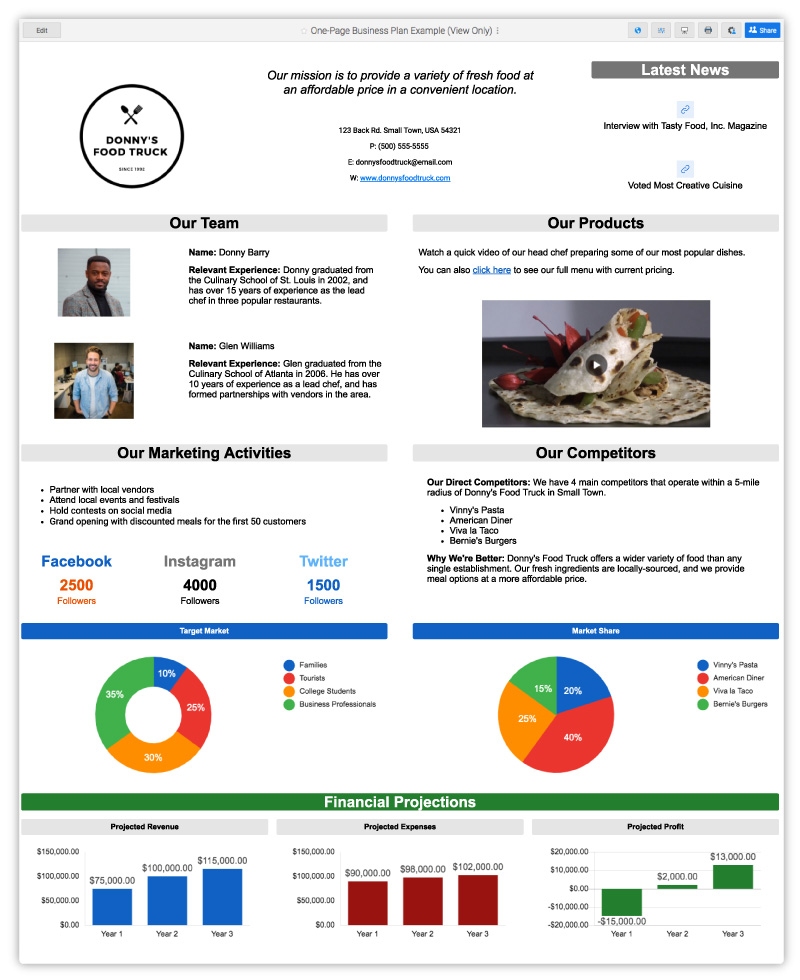
Startup Business Plan Sample
This business plan sample contains all the aspects of a standard business plan. Using a fictional food truck business as the basis for a startup business plan, this sample will give you all the ideas you need to make your plan outstanding.
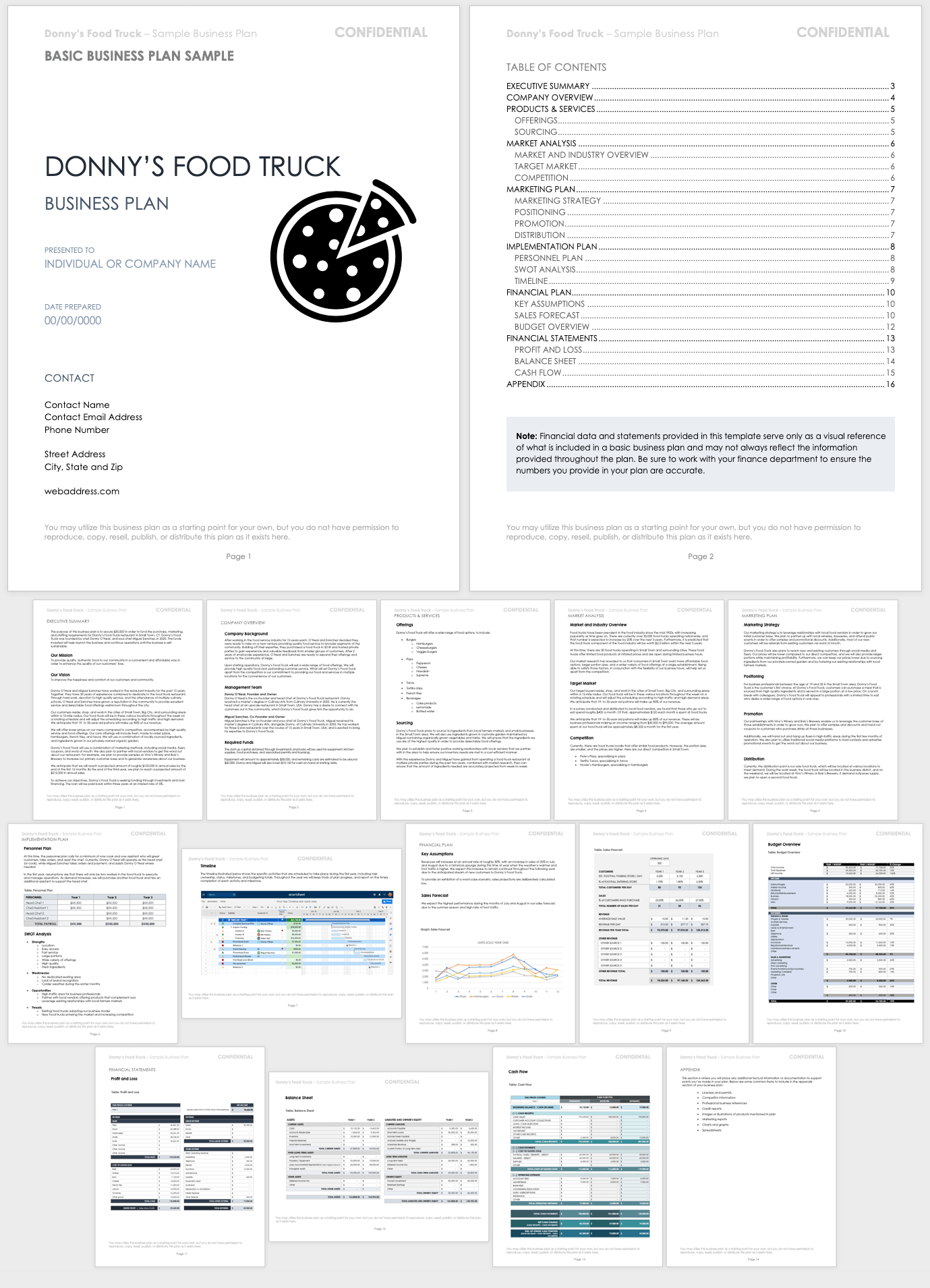
Download Startup Business Plan Sample - PDF
When the time comes that you need more space to lay out your goals and strategies, choose from our variety of free simple business plan templates . You can learn how to write a successful simple business plan here .
Visit this free non-profit business plan template roundup or of you are looking for a business plan template by file type, visit our pages dedicated specifically to Microsoft Excel , Microsoft Word , and Adobe PDF business plan templates. Read our articles offering free 30-60-90-day business plan templates to find more tailored options.
Top 10 Tips to Create a Startup Business Plan
Putting together a business plan can be overwhelming and time consuming, especially if you aren’t sure where to begin. Below, we share tips you can use to help simplify the process of developing a startup business plan of your own.
- Use a business plan template, or begin with a business plan outline that provides all the elements of a standard plan to get your ideas down on paper in a structured manner. (You can choose from the selection of templates above.)
- Remove sections from your outline that aren’t relevant or that aren’t necessary to launch and operate your business.
- Compile the data you have gathered on your business and industry, including research on your target market and product or service offerings, details on the competitive landscape, and a financial plan that anticipates the next three to five years. Use that information to fill in the sections of your plan outline.
- Get input and feedback from team members (e.g., finance, marketing, sales) and subject matter experts to ensure that the information you’ve included in the plan is accurate.
- Make certain that the objectives of your plan align with marketing, sales, and financial goals to ensure that all team members are moving in the same direction.
- Although this section of the plan comes first, write the executive summary last to provide an overview of the key points in your business plan.
- Prepare a pitch deck for potential clients, partners, or investors with whom you plan to meet in order to share vital information about your business, including what sets you apart and the direction you are headed.
- Who are the founders and management executives, and what relevant experience do they bring to the table?
- What is the problem you are solving, and how is your solution better than what currently exists?
- What’s the size of the market, and how much market share do you plan to capture?
- What are the trends in your market, and how are you applying them to your business?
- Who are your direct competitors, and what is your competitive advantage?
- What are the key features of your product or service that set it apart from alternative offerings, and what features do you plan to add in the future?
- What are the potential risks associated with your business, and how do you plan to address them?
- How much money do you need to get your business running, and how do you plan to source it?
- With the money you source, how do you plan to use it to scale your business?
- What are the key performance metrics associated with your business, and how will you know when you’re successful?
- Revisit and modify your plan on a regular basis as your goals and strategies evolve.
- Use a work collaboration tool that keeps key information across teams in one place, allows you to track plan progress, and captures updates in real time.
Successfully Implement Your Startup Business Plan with Real-Time Work Management in Smartsheet
Empower your people to go above and beyond with a flexible platform designed to match the needs of your team — and adapt as those needs change.
The Smartsheet platform makes it easy to plan, capture, manage, and report on work from anywhere, helping your team be more effective and get more done. Report on key metrics and get real-time visibility into work as it happens with roll-up reports, dashboards, and automated workflows built to keep your team connected and informed.
When teams have clarity into the work getting done, there’s no telling how much more they can accomplish in the same amount of time. Try Smartsheet for free, today.
Discover why over 90% of Fortune 100 companies trust Smartsheet to get work done.
How To Write A Business Plan: A Comprehensive Guide
The Startups Team

How To Write A Business Plan: A Comprehensive Guide
A comprehensive, step-by-step guide - complete with real examples - on writing business plans with just the right amount of panache to catch an investor's attention and serve as a guiding star for your business.
Introduction to Business Plans
So you've got a killer startup idea. Now you need to write a business plan that is equally killer.
You fire up your computer, open a Google doc, and stare at the blank page for several minutes before it suddenly dawns on you that, Hm…maybe I have no idea how to write a business plan from scratch after all.
Don't let it get you down. After all, why would you know anything about business planning? For that very reason we have 4 amazing business plan samples to share with you as inspiration.

For most founders, writing a business plan feels like the startup equivalent of homework. It's the thing you know you have to do, but nobody actually wants to do.
Here's the good news: writing a business plan doesn't have to be this daunting, cumbersome chore.
Once you understand the fundamental questions that your business plan should answer for your readers and how to position everything in a way that compels your them to take action, writing a business plan becomes way more approachable.
Before you set fingers to the keyboard to turn your business idea into written documentation of your organizational structure and business goals, we're going to walk you through the most important things to keep in mind (like company description, financials, and market analysis, etc.) and to help you tackle the writing process confidently — with plenty of real life business plan examples along the way to get you writing a business plan to be proud of!
Keep It Short and Simple.
There's this old-school idea that business plans need to be ultra-dense, complex documents the size of a doorstop because that's how you convey how serious you are about your company.
Not so much.
Complexity and length for complexity and length's sake is almost never a good idea, especially when it comes to writing a business plan. There are a couple of reasons for this.
1. Investors Are Short On Time
If your chief goal is using your business plan to secure funding, then it means you intend on getting it in front of an investor. And if there's one thing investors are, it's busy. So keep this in mind throughout writing a business plan.
Investors wade through hundreds of business plans a year. There's no version of you presenting an 80-page business plan to an investor and they enthusiastically dive in and take hours out of their day to pour over the thing front to back.
Instead, they're looking for you to get your point across as quickly and clearly as possible so they can skim your business plan and get to the most salient parts to determine whether or not they think your opportunity is worth pursuing (or at the very least initiating further discussions).
You should be able to refine all of the key value points that investors look for to 15-20 pages (not including appendices where you will detail your financials). If you find yourself writing beyond that, then it's probably a case of either over explaining, repeating information, or including irrelevant details in your business plan (you don't need to devote 10 pages to how you're going to set up your website, for example).
Bottom line: always be on the lookout for opportunities to “trim the fat" while writing a business plan (and pay special attention to the executive summary section below), and you'll be more likely to secure funding.
2. Know Your Audience
If you fill your business plan with buzzwords, industry-specific jargon or acronyms, and long complicated sentences, it might make sense to a handful of people familiar with your niche and those with superhuman attention spans (not many), but it alienates the vast majority of readers who aren't experts in your particular industry. And if no one can understand so much as your company overview, they won't make it through the rest of your business plan.
Your best bet here is to use simple, straightforward language that's easily understood by anyone — from the most savvy of investor to your Great Aunt Bertha who still uses a landline.
How To Format Your Business Plan
You might be a prodigy in quantum mechanics, but if you show up to your interview rocking cargo shorts and lime green Crocs, you can probably guess what the hiring manager is going to notice first.
In the same way, how you present your business plan to your readers equally as important as what you present to them. So don't go over the top with an extensive executive summary, or get lazy with endless bullet points on your marketing strategy.
If your business plan is laden with inconsistent margins, multiple font types and sizes, missing headings and page numbers, and lacks a table of contents, it's going to create a far less digestible reading experience (and totally take away from your amazing idea and hours of work writing a business plan!)
While there's no one right way to format your business plan, the idea here is to ensure that it presents professionally. Here's some easy formatting tips to help you do just that.
If your margins are too narrow, it makes the page look super cluttered and more difficult to read.
A good rule of thumb is sticking to standard one-inch margins all around.
Your business plan is made up of several key sections, like chapters in a book.
Whenever you begin a section (“Traction” for example) you'll want to signify it using a header so that your reader immediately knows what to expect from the content that follows.
This also helps break up your content and keep everything nice and organized in your business plan.
Subheadings
Subheadings are mini versions of headings meant to break up content within each individual section and capture the attention of your readers to keep them moving down the page.
In fact, we're using sub-headers right now in this section for that very purpose!
Limit your business plan to two typefaces (one for headings and one for body copy and subheadings, for example) that you can find in a standard text editor like Microsoft Word or Google Docs.
Only pick fonts that are easy to read and contain both capital and lowercase letters.
Avoid script-style or jarring fonts that distract from the actual content. Modern, sans-serif fonts like Helvetica, Arial, and Proxima Nova are a good way to go.
Keep your body copy between 11 and 12-point font size to ensure readability (some fonts are more squint-inducing than others).
You can offset your headings from your body copy by simply upping the font size and by bolding your subheadings.
Sometimes it's better to show instead of just tell.
Assume that your readers are going to skim your plan rather than read it word-for-word and treat it as an opportunity to grab their attention with color graphics, tables, and charts (especially with financial forecasts), as well as product images, if applicable.
This will also help your reader better visualize what your business model is all about.
Need some help with this?
Our business planning wizard comes pre-loaded with a modular business plan template that you can complete in any order and makes it ridiculously easy to generate everything you need from your value proposition, mission statement, financial projections, competitive advantage, sales strategy, market research, target market, financial statements, marketing strategy, in a way that clearly communicates your business idea.
Refine Your Business Plans. Then Refine Them Some More.
Your business isn't static, so why should your business plan be?
Your business strategy is always evolving, and so are good business plans. This means that the early versions of your business plans probably won't (and shouldn't be) your last. The details of even even the best business plans are only as good as their last update.
As your business progresses and your ideas about it shift, it's important revisit your business plan from time to time to make sure it reflects those changes, keeping everything as accurate and up-to-date as possible. What good is market analysis if the market has shifted and you have an entirely different set of potential customers? And what good would the business model be if you've recently pivoted? A revised business plan is a solid business plan. It doesn't ensure business success, but it certainly helps to support it.
This rule especially holds true when you go about your market research and learn something that goes against your initial assumptions, impacting everything from your sales strategy to your financial projections.
At the same time, before you begin shopping your business plan around to potential investors or bankers, it's imperative to get a second pair of eyes on it after you've put the final period on your first draft.
After you run your spell check, have someone with strong “English teacher skills” run a fine-tooth comb over your plan for any spelling, punctuation, and grammatical errors you may have glossed over. An updated, detailed business plan (without errors!) should be constantly in your business goals.
More than that, your trusty business plan critic can also give you valuable feedback on how it reads from a stylistic perspective. While different investors prefer different styles, the key here is to remain consistent with your audience and business.
Writing Your Business Plan: A Section-By-Section Breakdown
We devoted an entire article carefully breaking down the key components of a business plan which takes a comprehensive look of what each section entails and why.
If you haven't already, you should check that out, as it will act as the perfect companion piece to what we're about to dive into in a moment.
For our purposes here, we're going to look at a few real world business plan examples (as well as one of our own self-penned “dummy” plans) to give you an inside look at how to position key information on a section-by-section basis.
1. Executive Summary
Quick overview.
After your Title Page — which includes your company name, slogan (if applicable), and contact information — and your Table of Contents, the Executive Summary will be the first section of actual content about your business.
The primary goal of your Executive Summary is to provide your readers with a high level overview of your business plan as a whole by summarizing the most important aspects in a few short sentences. Think of your Executive Summary as a kind of “teaser” for your business concept and the information to follow — information which you will explain in greater detail throughout your plan. This isn't the place for your a deep dive on your competitive advantages, or cash flow statement. It is an appropriate place to share your mission statement and value proposition.
Executive Summary Example
Here's an example of an Executive Summary taken from a sample business plan written by the Startups.com team for a fictional company called Culina. Here, we'll see how the Executive Summary offers brief overviews of the Product , Market Opportunity , Traction , and Next Steps .
Culina Tech specializes in home automation and IoT technology products designed to create the ultimate smart kitchen for modern homeowners.
Our flagship product, the Culina Smart Plug, enables users to make any kitchen appliance or cooking device intelligent. Compatible with all existing brands that plug into standard two or three-prong wall outlets, Culina creates an entire network of Wi-Fi-connected kitchen devices that can be controlled and monitored remotely right from your smartphone.
The majority of US households now spend roughly 35% of their energy consumption on appliances, electronics, and lighting. With the ability to set energy usage caps on a daily, weekly or monthly basis, Culina helps homeowners stay within their monthly utility budget through more efficient use of the dishwasher, refrigerator, freezer, stove, and other common kitchen appliances.
Additionally, 50.8% of house fires are caused in the kitchen — more than any other room in the home — translating to over $5 billion in property damage costs per year. Culina provides the preventative intelligence necessary to dramatically reduce kitchen-related disasters and their associated costs and risk of personal harm.
Our team has already completed the product development and design phase, and we are now ready to begin mass manufacturing. We've also gained a major foothold among consumers and investors alike, with 10,000 pre-ordered units sold and $5 million in investment capital secured to date.
We're currently seeking a $15M Series B capital investment that will give us the financial flexibility to ramp up hardware manufacturing, improve software UX and UI, expand our sales and marketing efforts, and fulfill pre-orders in time for the 2018 holiday season.
2. Company Synopsis
Your Company Synopsis section answers two critically important questions for your readers: What painful PROBLEM are you solving for your customers? And what is your elegant SOLUTION to that problem? The combination of these two components form your value proposition.
Company Synopsis Example
Let's look at a real-life company description example from HolliBlu * — a mobile app that connects healthcare facilities with local skilled nurses — to see how they successfully address both of these key aspects. *Note: Full disclosure; Our team worked directly with this company on their business plan via Fundable.

Notice how we get a crystal clear understanding of why the company exists to begin with when they set up the problem — that traditional nurse recruitment methods are costly, inconvenient, and time-consuming, creating significant barriers to providing quality nursing to patients in need.
Once we understand the painful problem that HolliBlu's customers face, we're then directly told how their solution links back directly to that problem — by creating an entire community of qualified nurses and directly connecting them with local employers more cost-effectively and more efficiently than traditional methods.
3. Market Overview
Your Market Overview provides color around the industry that you will be competing in as it relates to your product/service.
This will include statistics about industry size, [growth](https://www.startups.com/library/expert-advice/the-case-for-growing-slowly) rate, trends, and overall outlook. If this part of your business plan can be summed up in one word, it's research .
The idea is to gather as much raw data as you can to make the case for your readers that:
This is a market big enough to get excited about.
You can capture a big enough share of this market to get excited about.
Target Market Overview Example
Here's an example from HolliBlu's business plan:

HolliBlu's Market Overview hits all of the marks — clearly laying out the industry size ($74.8 billion), the Total Addressable Market or TAM (3 million registered nurses), industry growth rate (581,500 new RN jobs through 2018; $355 billion by 2020), and industry trends (movement toward federally-mandated compliance with nurse/patient ratios, companies offering sign-on bonuses to secure qualified nurses, increasing popularity of home-based healthcare).
4. Product (How it Works)
Where your Company Synopsis is meant to shed light on why the company exists by demonstrating the problem you're setting out to solve and then bolstering that with an impactful solution, your Product or How it Works section allows you to get into the nitty gritty of how it actually delivers that value, and any competitive advantage it provides you.
Product (How it Works) Example
In the below example from our team's Culina sample plan, we've divided the section up using subheadings to call attention to product's key features and how it actually works from a user perspective.
This approach is particularly effective if your product or service has several unique features that you want to highlight.
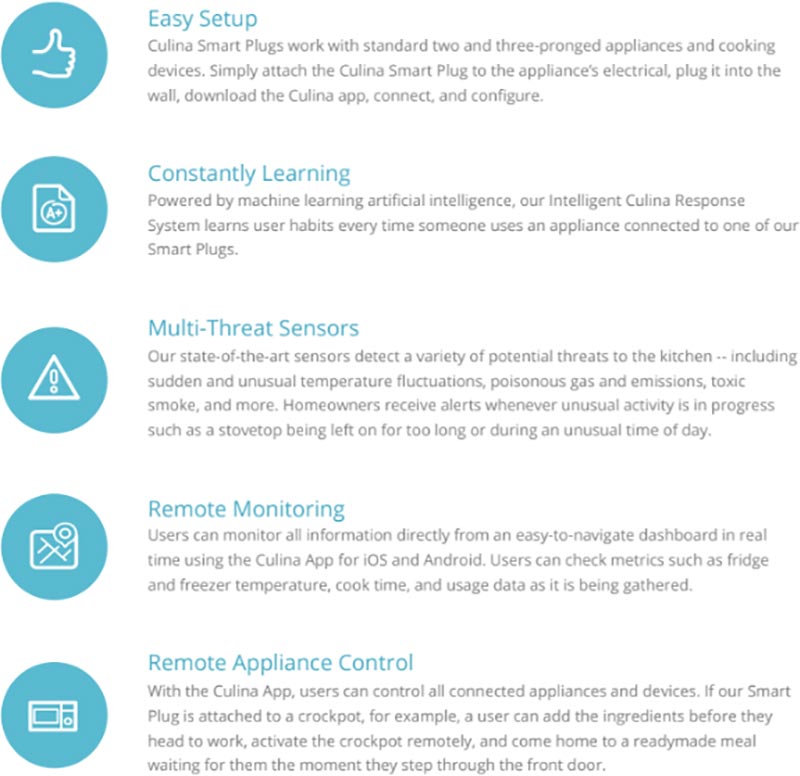
5. Revenue Model
Quite simply, your Revenue Model gives your readers a framework for how you plan on making money. It identifies which revenue channels you're leveraging, how you're pricing your product or service, and why.
Revenue Model Example
Let's take a look at another real world business plan example with brewpub startup Magic Waters Brewpub .*
It can be easy to get hung up on the financial aspect here, especially if you haven't fully developed your product yet. And that's okay. *Note: Full disclosure; Our team worked directly with this company on their business plan via Fundable.
The thing to remember is that investors will want to see that you've at least made some basic assumptions about your monetization strategy.

6. Operating Model
Your Operating Model quite simply refers to how your company actually runs itself. It's the detailed breakdown of the processes, technologies, and physical requirements (assets) that allow you to deliver the value to your customers that your product or service promises.
Operating Model Example
Let's say you were opening up a local coffee shop, for example. Your Operating Model might detail the following:
Information about your facility (location, indoor and outdoor space features, lease amount, utility costs, etc.)
The equipment you need to purchase (coffee and espresso machines, appliances, shelving and storage, etc.) and their respective costs.
The inventory you plan to order regularly (product, supplies, etc.), how you plan to order it (an online supplier) and how often it gets delivered (Mon-Fri).
Your staffing requirements (including how many part or full time employees you'll need, at what wages, their job descriptions, etc.)
In addition, you can also use your Operating Model to lay out the ways you intend to manage the costs and efficiencies associated with your business, including:
The Critical Costs that make or break your business. In the case of our coffee shop example, you might say something like,
“We're estimating the marketing cost to acquire a customer is going to be $25. Our average sale is $45. So long as we can keep our customer acquisition costs below $25 we will have enough margin to grow with.”
Cost Maturation & Milestones that show how your Critical Costs might fluctuate over time.
“If we sell 50 coffees a day, our average unit cost will be $8 on a sale of $10. At that point we're barely breaking even. However as we scale up to 200 coffees a day, our unit costs drop significantly to $4, creating a 100% increase in net income.”
Investment Costs that highlight strategic uses of capital that will have a big Return on Investment (ROI) later.
“We're investing $100,000 into a revolutionary new coffee brewing system that will allow us to brew twice the amount our current output with the same amount of space and staff.”
Operating Efficiencies explaining your capability of delivering your product or service in the most cost effective manner possible while maintaining the highest standards of quality.
“By using energy efficient Ecoboilers, we're able to keep our water hot while minimizing the amount of energy required. Our machines also feature an energy saving mode. Both of these allow us to dramatically cut energy costs.”
7. Competitive Analysis
Like the Market Overview section, you want to show your readers that you've done your homework and have a crazy high level of awareness about your current competitors or any potential competitors that may crop up down the line for your given business model.
When writing your Competitive Analysis, your overview should cover who your closest competitors are, the chief strengths they bring to the table, and their biggest weaknesses .
You'll want to identify at least 3 competitors — either direct, indirect, or a combination of the two. It's an extremely important aspect of the business planning process.
Competition Analysis Example
Here's an example of how HolliBlu lays out their Competitive Analysis section for just one of their competitors, implementing each of the criteria noted above:
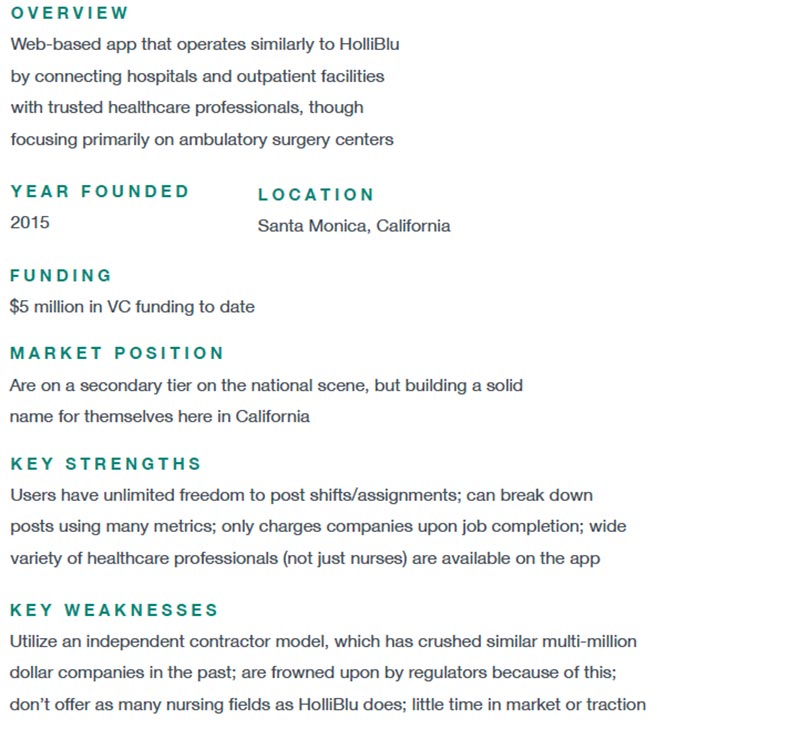
8. Customer Definition
Your Customer Definition section allows you to note which customer segment(s) you're going after, what characteristics and habits each customer segment embodies, how each segment uniquely benefits from your product or service, and how all of this ties together to create the ideal portrait of an actual paying customer, and how you'll cultivate and manage customer relationships.
Customer Definition Example
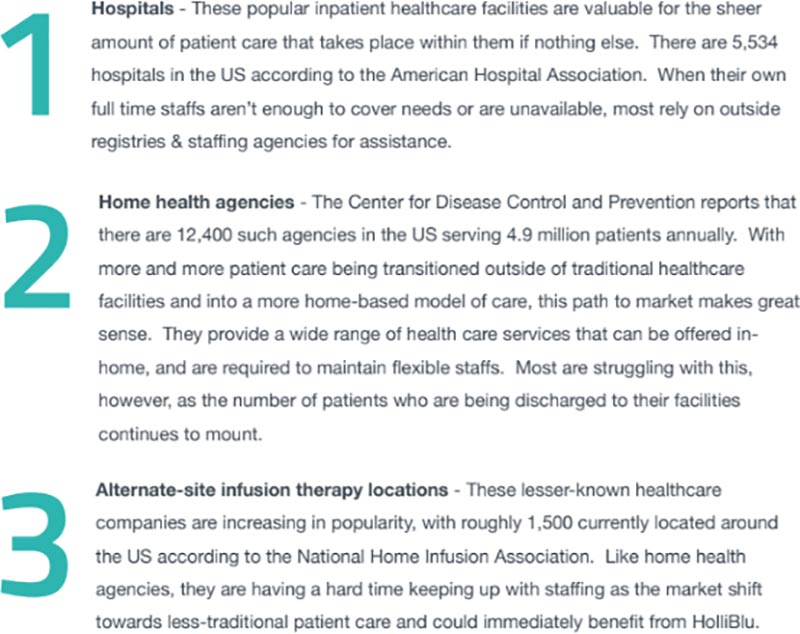
HolliBlu's Customer Definition section is effective for several reasons. Let's deconstruct their first target market segment, hospitals.
What's particularly successful here is that we are explained why hospitals are optimal buyers.
They accomplish this by harkening back to the central problem at the core of the opportunity (when hospitals can't supply enough staff to meet patient demands, they have to resort on costly staffing agencies).
On top of that, we are also told how big of an opportunity going after this customer segment represents (5,534 hospitals in the US).
This template is followed for each of the company's 3 core customer segments. This provides consistency, but more than that, it emphasizes how diligent research reinforces their assumptions about who their customers are and why they'd open their wallets. Keep all of this in mind when you are write your own business plan.
9. Customer Acquisition
Now that you've defined who your customers are for your readers, your Customer Acquisition section will tell them what marketing and sales strategy and tactics you plan to leverage to actually reach the target market (or target markets) and ultimately convert them into paying customers.
marketing Strategy Example
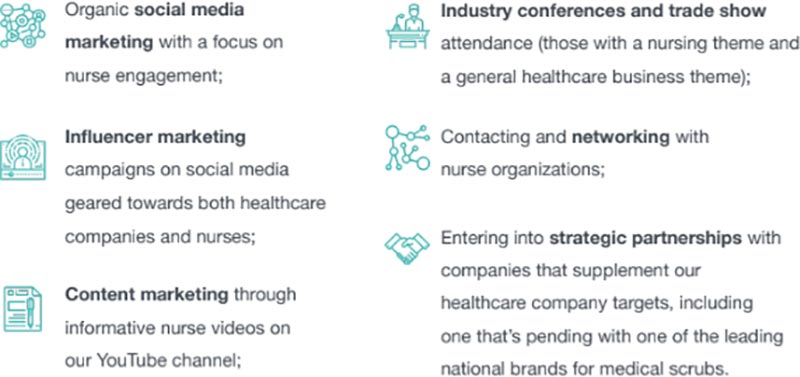
Similar to the exercise you will go through with your Revenue Model, in addition to identifying which channels you're pursuing, you'll also want to detail all of relevant costs associated with your customer acquisition channels.
Let's say you spent $100 on your marketing plan to acquire 100 customers during 2018. To get your CAC, you simply divide the number of customers acquired by your spend, giving you a $1.00 CAC.
10. Traction
This one's huge. Traction tells investors one important thing: that you're business has momentum. It's evidence that you're making forward progress and hitting milestones. That things are happening. It's one of the most critical components of a successful business plan.
Why is this so important? Financial projections are great and all, but if you can prove to investors that your company's got legs before they've even put a dime into it, then it will get them thinking about all the great things you'll be able to accomplish when they do bankroll you.
Traction Example
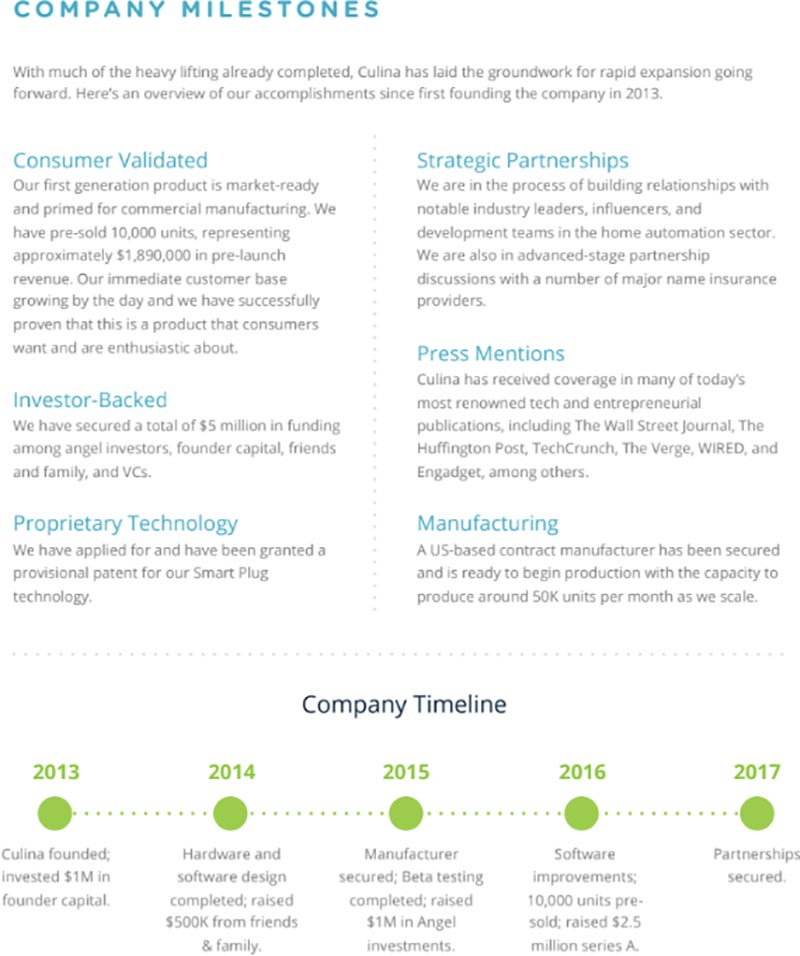
In our Culina Traction section, we've called attention to several forms of traction, touching on some of the biggest ones that you'll want to consider when writing your own plan.
Have I built or launched my product or service yet?
Have I reached any customers yet?
Have I generated any revenue yet?
Have I forged any strategic industry relationships that will be instrumental in driving growth?
The key takeaway here: the more traction you can show, the more credibility you build with investors. After all, you can't leave it all on market analysis alone.
11. Management Team
Here's what your Management Team section isn't: it's not an exhaustive rundown of each and every position your team members have held over the course of their lives.
Instead, you should tell investors which aspects of your team's experience and expertise directly translates to the success of this company and this industry.
In other words, what applicable, relevant background do they bring to the table?
Management Team Example
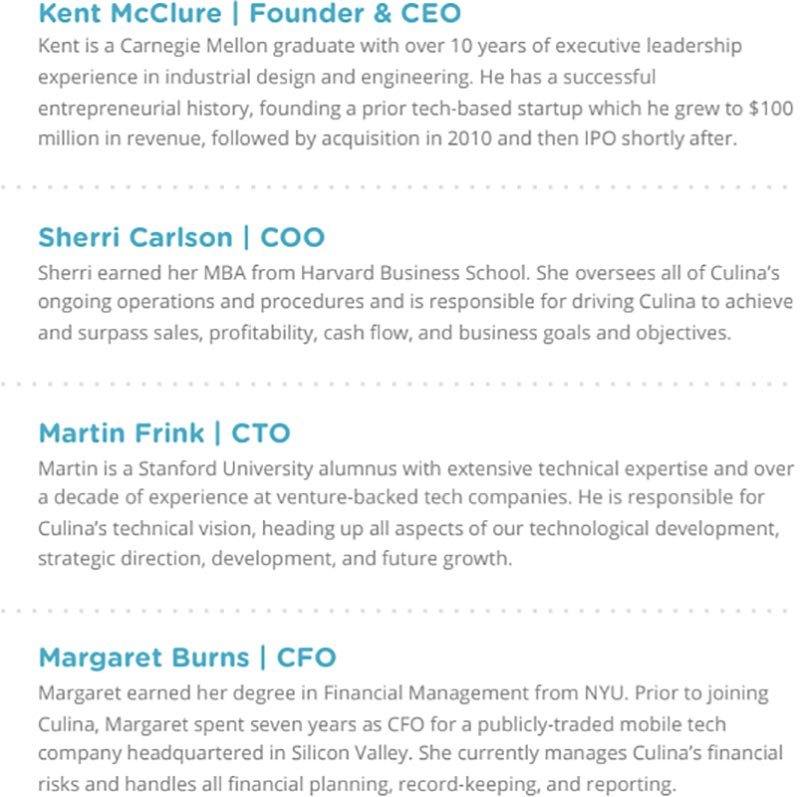
Let's be real. The vast majority of startup teams probably aren't stacked with Harvard and Stanford grads. But the thing to home in on is how the prior experience listed speaks directly to how it qualifies that team member's current position.
The word of the day here is relevancy. If it's not relevant, you probably don't need to include it in your typical business plan.
12. Funding
Funding overview.
The ask! This is where you come out and, you guessed it, ask your investors point blank how much money you need to move your business forward, what specific milestones their investment will allow you to reach, how you'll allocate the capital you secure, and what the investor will get in exchange for their investment.
You can also include information about your exit strategy (IPO, acquisition, merger?).
Funding Example
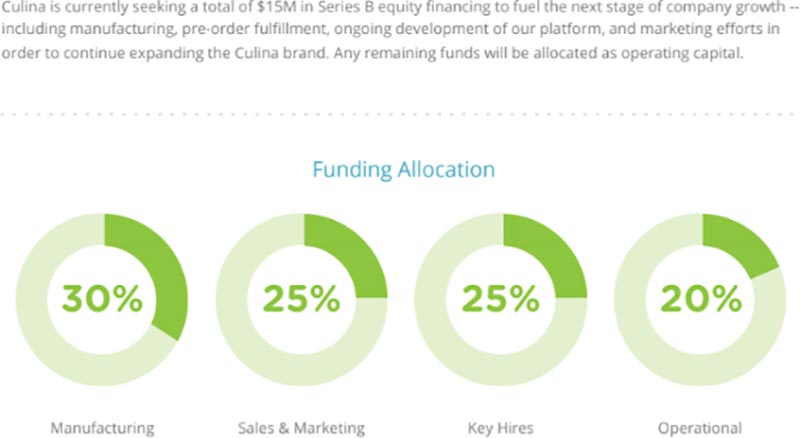
While we've preached against redundancy in your business plan, an exception to the rule is using the Funding section to offer up a very brief recap that essentially says, “here are the biggest reasons you should invest in my company and why it will ultimately benefit you.”
13. Financials
Spreadsheets and numbers and charts, oh my! Yes, it's everybody's “favorite” business plan section: Financials.
Your Financials section will come last and contain all of the forecasted numbers that say to investors that this is a sound investment. This will include things like your sales forecast, expense budget, and break-even analysis. A lot of this will be assumptions, or estimates.
The key here is keeping those estimates as realistic as humanly possible by breaking your figures into components and looking at each one individually.
Financials Example

The balance sheet above illustrates the business' estimated net worth over a three-year period by summarizing its assets (tangible objects owned by the company), liabilities (debt owed to a creditor of the company), and shareholders' equity (source of financing used to fund the assets).
In plain words, the balance sheet is basically a snapshot of your business' financial status by laying out what you own and owe, helping investors determine the level of risk involved and giving them a good understanding of the financial health of the business.
If you're looking to up your game from those outdated Excel-style spreadsheets, our business planning software will help you create clean, sleek, modern financial reports the modern way. Plus, it's as easy to use as it is attractive to look at. You might even find yourself enjoying financial projections, building a cash flow statement, and business planning overall.
You've Got This!
You've committed to writing your business plan and now you've got some tricks of the trade to help you out along the way. Whether you're applying for a business loan or seeking investors, your well-crafted business plan will act as your Holy Grail in helping take your business goals to the next plateau.
This is a ton of work. It's not a few hours and a free business plan template. It's not just a business plan software. We've been there before. Writing your [business plan](https://www.startups.com/library/expert-advice/top-4-business-plan-examples) is just one small step in startup journey. There's a whole long road ahead of you filled with a marketing plan, investor outreach, chasing venture capitalists, actually getting funded, and growing your business into a successful company.
And guess what? We've got helpful information on all of it — and all at your disposal! We hope this guides you confidently on how to write a business plan worth bragging about.
Find this article helpful?
This is just a small sample! Register to unlock our in-depth courses, hundreds of video courses, and a library of playbooks and articles to grow your startup fast. Let us Let us show you!

IMAGES
VIDEO
COMMENTS
Read our simple guide to learn how to write a business plan quickly and easily. A solid business plan is essential for any new business. Every business starts with a vision, which is...
Learn how to create an effective business plan in 10 easy steps and discover the transformative power of mentorship to elevate your startup's strategy.
1. Startups. Startup business plans are for proposing new business ideas. If you’re planning to start a small business, preparing a business plan is crucial. The plan should include all the major factors of your business. You can …
In this article, we’ve rounded up a variety of the top, professionally designed startup business plan templates, all of which are free to download in PDF, Word, and Excel formats. Included on this page, you’ll find a one-page …
A comprehensive, step-by-step guide - complete with real examples - on writing business plans with just the right amount of panache to catch an investor's attention and serve as a guiding star for your business.